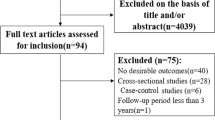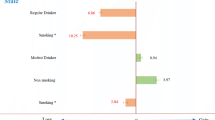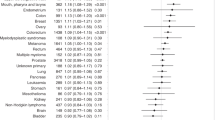Abstract
Background/Objectives:
It is unknown if wine, beer and spirit intake lead to a similar association with diabetes. We studied the association between alcoholic beverage preference and type 2 diabetes incidence in persons who reported to consume alcohol.
Subjects/Methods:
Ten European cohort studies from the Consortium on Health and Ageing: Network of Cohorts in Europe and the United States were included, comprising participant data of 62 458 adults who reported alcohol consumption at baseline. Diabetes incidence was based on documented and/or self-reported diagnosis during follow-up. Preference was defined when ⩾70% of total alcohol consumed was either beer, wine or spirits. Adjusted hazard ratios (HRs) were computed using Cox proportional hazard regression. Single-cohort HRs were pooled by random-effects meta-analysis.
Results:
Beer, wine or spirit preference was not related to diabetes risk compared with having no preference. The pooled HRs were HR 1.06 (95% confidence interval (CI) 0.93, 1.20) for beer, HR 0.99 (95% CI 0.88, 1.11) for wine, and HR 1.19 (95% CI 0.97, 1.46) for spirit preference. Absolute wine intake, adjusted for total alcohol, was associated with a lower diabetes risk: pooled HR per 6 g/day was 0.96 (95% CI 0.93, 0.99). A spirit preference was related to a higher diabetes risk in those with a higher body mass index, in men and women separately, but not after excluding persons with prevalent diseases.
Conclusions:
This large individual-level meta-analysis among persons who reported alcohol consumption revealed that the preference for beer, wine, and spirits was similarly associated with diabetes incidence compared with having no preference.
This is a preview of subscription content, access via your institution
Access options
Subscribe to this journal
Receive 12 print issues and online access
$259.00 per year
only $21.58 per issue
Buy this article
- Purchase on Springer Link
- Instant access to full article PDF
Prices may be subject to local taxes which are calculated during checkout






Similar content being viewed by others
References
International Diabetes Federation. IDF Diabetes Atlas, 6th edn, 2014. Available at: http://www.idf.org/diabetesatlas (accessed 12 March 2015).
Li XH, Yu FF, Zhou YH, He J . Association between alcohol consumption and the risk of incident type 2 diabetes: a systematic review and dose-response meta-analysis. Am J Clin Nutr 2016; 103: 818–829.
Baliunas DO, Taylor BJ, Irving H, Roerecke M, Patra J, Mohapatra S et al. Alcohol as a risk factor for type 2 diabetes: a systematic review and meta-analysis. Diabetes Care 2009; 32: 2123–2132.
Knott C, Bell S, Britton A . Alcohol consumption and the risk of type 2 diabetes: a systematic review and dose-response meta-analysis of more than 1.9 million individuals from 38 observational studies. Diabetes Care 2015; 38: 1804–1812.
Huang J, Wang X, Zhang Y . Specific types of alcoholic beverage consumption and risk of type 2 diabetes: a systematic review and meta-analysis. J Diabetes Invest 2016; 8: 56–68.
Beulens JW, van der Schouw YT, Bergmann MM, Rohrmann S, Schulze MB, Buijsse B et al. Alcohol consumption and risk of type 2 diabetes in European men and women: influence of beverage type and body size The EPIC-InterAct study. J Intern Med 2012; 272: 358–370.
Brien SE, Ronksley PE, Turner BJ, Mukamal KJ, Ghali WA . Effect of alcohol consumption on biological markers associated with risk of coronary heart disease: systematic review and meta-analysis of interventional studies. BMJ 2011; 342: d636.
Schrieks IC, Heil AL, Hendriks HF, Mukamal KJ, Beulens JW . The effect of alcohol consumption on insulin sensitivity and glycemic status: a systematic review and meta-analysis of intervention studies. Diabetes Care 2015; 38: 723–732.
Gronbaek M . Confounders of the relation between type of alcohol and cardiovascular disease. Ann Epidemiol 2007; 17: S13–S15.
Sluik D, Bezemer R, Sierksma A, Feskens E . Alcoholic beverage preference and dietary habits: a systematic literature review. Crit Rev Food Sci Nutr 2015; 56: 2370–2382.
Brand-Miller JC, Fatema K, Middlemiss C, Bare M, Liu V, Atkinson F et al. Effect of alcoholic beverages on postprandial glycemia and insulinemia in lean, young, healthy adults. Am J Clin Nutr 2007; 85: 1545–1551.
Hatonen KA, Virtamo J, Eriksson JG, Perala MM, Sinkko HK, Leiviska J et al. Modifying effects of alcohol on the postprandial glucose and insulin responses in healthy subjects. Am J Clin Nutr 2012; 96: 44–49.
Arranz S, Chiva-Blanch G, Valderas-Martinez P, Medina-Remon A, Lamuela-Raventos RM, Estruch R . Wine, beer, alcohol and polyphenols on cardiovascular disease and cancer. Nutrients 2012; 4: 759–781.
Wacholder S, Schatzkin A, Freedman LS, Kipnis V, Hartman A, Brown CC . Can energy adjustment separate the effects of energy from those of specific macronutrients? Am J Epidemiol 1994; 140: 848–855.
Boffetta P, Bobak M, Borsch-Supan A, Brenner H, Eriksson S, Grodstein F et al. The Consortium on Health and Ageing: Network of Cohorts in Europe and the United States (CHANCES) project—design, population and data harmonization of a large-scale, international study. Eur J Epidemiol 2014; 29: 929–936.
Buijsse B, Feskens EJ, Kok FJ, Kromhout D . Cocoa intake, blood pressure, and cardiovascular mortality: the Zutphen Elderly Study. Arch Intern Med 2006; 166: 411–417.
Hofman A, Brusselle GG, Darwish Murad S, van Duijn CM, Franco OH, Goedegebure A et al. The Rotterdam Study: 2016 objectives and design update. Eur J Epidemiol 2015; 30: 661–708.
Trichopoulou A, Orfanos P, Norat T, Bueno-de-Mesquita B, Ocke MC, Peeters PH et al. Modified Mediterranean diet and survival: EPIC-elderly prospective cohort study. BMJ 2005; 330: 991.
Jacobsen BK, Eggen AE, Mathiesen EB, Wilsgaard T, Njolstad I . Cohort profile: the Tromso Study. Int J Epidemiol 2012; 41: 961–967.
Schottker B, Haug U, Schomburg L, Kohrle J, Perna L, Muller H et al. Strong associations of 25-hydroxyvitamin D concentrations with all-cause, cardiovascular, cancer, and respiratory disease mortality in a large cohort study. Am J Clin Nutr 2013; 97: 782–793.
Evans A, Salomaa V, Kulathinal S, Asplund K, Cambien F, Ferrario M et al. MORGAM (an international pooling of cardiovascular cohorts). Int J Epidemiol 2005; 34: 21–27.
Di Castelnuovo A, de Curtis A, Costanzo S, Persichillo M, Olivieri M, Zito F et al. Association of D-dimer levels with all-cause mortality in a healthy adult population: findings from the MOLI-SANI study. Haematologica 2013; 98: 1476–1480.
Kuulasmaa K, Palosaari T (eds). Contributors from Partners of the Consortium on Health and Ageing: Network of Cohorts in Europe and the United States (CHANCES). CHANCES cohort descriptions, assessment of the availability and quality of data, and definitions of variables. MORGAM Project e-publications [Internet]. 2015; (6). URN:NBN:fi-fe201501151161. Available at: http://www.thl.fi/publications/morgam/chances_d9/index.html.
Klipstein-Grobusch K, den Breeijen JH, Goldbohm RA, Geleijnse JM, Hofman A, Grobbee DE et al. Dietary assessment in the elderly: validation of a semiquantitative food frequency questionnaire. Eur J Clin Nutr 1998; 52: 588–596.
Riboli E, Kaaks R . The EPIC Project: rationale and study design. European Prospective Investigation into Cancer and Nutrition. Int J Epidemiol 1997; 26: S6–S14.
Sluik D, van Lee L, Geelen A, Feskens EJ . Alcoholic beverage preference and diet in a representative Dutch population: the Dutch national food consumption survey 2007-2010. Eur J Clin Nutr 2014; 68: 287–294.
Sluik D, Jankovic N, O'Doherty MG, Geelen A, Schottker B, Rolandsson O et al. Alcoholic beverage preference and dietary habits in elderly across Europe: analyses within the Consortium on Health and Ageing: Network of Cohorts in Europe and the United States (CHANCES) Project. PloS One 2016; 11: e0161603.
Willett WC, Howe GR, Kushi LH . Adjustment for total energy intake in epidemiologic studies. Am J Clin Nutr 1997; 65: 1220S–1228S. discussion 1229S-1231S.
Jankovic N, Geelen A, Streppel MT, de Groot LC, Orfanos P, van den Hooven EH et al. Adherence to a healthy diet according to the World Health Organization guidelines and all-cause mortality in elderly adults from Europe and the United States. Am J Epidemiol 2014; 180: 978–988.
Sterne JA, White IR, Carlin JB, Spratt M, Royston P, Kenward MG et al. Multiple imputation for missing data in epidemiological and clinical research: potential and pitfalls. Bmj 2009; 338: b2393.
Sauerbrei W, Meier-Hirmer C, Benner A, Royston P . Multivariable regression model building by using fractional polynomials: description of SAS, STATA, and R programs. Comput Stat Data Anal 2006; 50: 3464–3485.
Hodge AM, English DR, O'Dea K, Giles GG . Alcohol intake, consumption pattern and beverage type, and the risk of Type 2 diabetes. Diabetic Med 2006; 23: 690–697.
Fagherazzi G, Vilier A, Lajous M, Boutron-Ruault MC, Balkau B, Clavel-Chapelon F et al. Wine consumption throughout life is inversely associated with type 2 diabetes risk, but only in overweight individuals: results from a large female French cohort study. Eur J Clin Epidemiol 2014; 29: 831–839.
Conigrave KM, Hu BF, Camargo CA Jr., Stampfer MJ, Willett WC, Rimm EB . A prospective study of drinking patterns in relation to risk of type 2 diabetes among men. Diabetes 2001; 50: 2390–2395.
Kao WH, Puddey IB, Boland LL, Watson RL, Brancati FL . Alcohol consumption and the risk of type 2 diabetes mellitus: atherosclerosis risk in communities study. Am J Epidemiol 2001; 154: 748–757.
Wannamethee SG, Camargo CA Jr., Manson JE, Willett WC, Rimm EB . Alcohol drinking patterns and risk of type 2 diabetes mellitus among younger women. Arch Intern Med 2003; 163: 1329–1336.
Chiva-Blanch G, Urpi-Sarda M, Ros E, Valderas-Martinez P, Casas R, Arranz S et al. Effects of red wine polyphenols and alcohol on glucose metabolism and the lipid profile: a randomized clinical trial. Clin Nutr 2013; 32: 200–206.
Gronbaek M . Factors influencing the relation between alcohol and mortality—with focus on wine. J Intern Med 2001; 250: 291–308.
Rehm J, Irving H, Ye Y, Kerr WC, Bond J, Greenfield TK . Are lifetime abstainers the best control group in alcohol epidemiology? On the stability and validity of reported lifetime abstention. Am J Epidemiol 2008; 168: 866–871.
Shaper AG, Wannamethee G, Walker M . Alcohol and mortality in British men: explaining the U-shaped curve. Lancet 1988; 2: 1267–1273.
Di Castelnuovo A, Costanzo S, Bagnardi V, Donati MB, Iacoviello L . de Gaetano G. Alcohol dosing and total mortality in men and women: an updated meta-analysis of 34 prospective studies. Arch Intern Med 2006; 166: 2437–2445.
Schisterman EF, Cole SR, Platt RW . Overadjustment bias and unnecessary adjustment in epidemiologic studies. Epidemiology 2009; 20: 488–495.
Collaboration NCDRF. Effects of diabetes definition on global surveillance of diabetes prevalence and diagnosis: a pooled analysis of 96 population-based studies with 331 288 participants. Lancet 2015; 3: 624–637.
Ryden L, Standl E, Bartnik M, Van den Berghe G, Betteridge J, de Boer MJ et al. Guidelines on diabetes, pre-diabetes, and cardiovascular diseases: executive summary. The Task Force on Diabetes and Cardiovascular Diseases of the European Society of Cardiology (ESC) and of the European Association for the Study of Diabetes (EASD). Eur Heart J 2007; 28: 88–136.
American Diabetes Association. Nutrition recommendations and interventions for diabetes: a position statement of the American Diabetes Association. Diabetes care 2008; 31: S61–S78.
Feskens EJ, Loeber JG, Kromhout D . Diet and physical activity as determinants of hyperinsulinemia: the Zutphen Elderly Study. Am J Epidemiol 1994; 140: 350–360.
Beulens JW, Stolk RP, van der Schouw YT, Grobbee DE, Hendriks HF, Bots ML . Alcohol consumption and risk of type 2 diabetes among older women. Diabetes Care 2005; 28: 2933–2938.
Kulathinal S, Niemelä M, Niiranen T, Saarela O, Palosaari T, Tapanainen H et al Description of MORGAM Cohorts. MORGAM Project e-publications [Internet]. 2005-; (2). URN:NBN:fi-fe20051214. Available at: http://www.thl.fi/publications/morgam/cohorts/index.html.
Acknowledgements
The research of DS was supported by the Dutch Beer Institute and the European Foundation for Alcohol Research (ERAB). The sponsor did not have any role in the design and conduct of the study; collection, management, analysis and interpretation of the data; and preparation, review or approval of the manuscript. No other authors declare conflicts of interest. This analysis was part of the Consortium on Health and Ageing (CHANCES) project funded in the FP7 framework programme of the Directorate-General for Research and Innovation in the European Commission (grant 242244). The CHANCES project is coordinated by the Hellenic Health Foundation, Greece. Harmonization of the data from the MORGAM cohorts was also supported by European Union FP 7 project BiomarCaRE (278913). DS, FK and EJMF designed the study and formulated the research question. OHF, DK, AT, TW, HB, KK, TL, SS, LI and PB acquired the data and contributed reagents/materials/analysis tools. DS carried out the study, analyzed the data and drafted the manuscript. All authors critically revised the manuscript for important intellectual content and approved of the final version to be published. The research of DS was supported by the Dutch Beer Institute and the European Foundation for Alcohol Research (ERAB). The sponsor did not have any role in the design and conduct of the study; collection, management, analysis and interpretation of the data; and preparation, review or approval of the manuscript.
Author information
Authors and Affiliations
Corresponding author
Ethics declarations
Competing interests
The authors declare no conflict of interest.
Additional information
Supplementary Information accompanies this paper on European Journal of Clinical Nutrition website
Rights and permissions
About this article
Cite this article
Sluik, D., Jankovic, N., Hughes, M. et al. Alcoholic beverage preference and diabetes incidence across Europe: the Consortium on Health and Ageing Network of Cohorts in Europe and the United States (CHANCES) project. Eur J Clin Nutr 71, 659–668 (2017). https://doi.org/10.1038/ejcn.2017.4
Received:
Revised:
Accepted:
Published:
Issue Date:
DOI: https://doi.org/10.1038/ejcn.2017.4
This article is cited by
-
A pilot study on the effect of d-allulose on postprandial glucose levels in patients with type 2 diabetes mellitus during Ramadan fasting
Diabetology & Metabolic Syndrome (2022)
-
Alcohol consumption and incidence of proteinuria: a retrospective cohort study
Clinical and Experimental Nephrology (2018)



